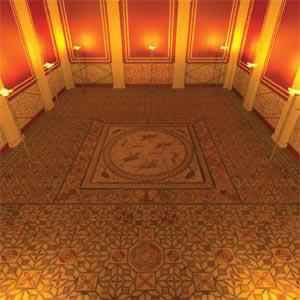
Archaeological sites reveal countless insights into how our ancestors lived. But how can we get closer to actually experiencing what life was really like in the past?
One answer is to make computer simulations, such as the fascinating Google Earth reconstruction of ancient Rome. But Alan Chalmers of the Digital Laboratory at the University of Warwick believes that such simulations can be made far more realistic by considering how the reconstructed scenes would have been lit.
Today we're used to the glare of modern halogen lighting, and this is how artefacts such as mosaics, pottery or cave paintings tend to be illuminated when they are on display. But Chalmers argues that this bears little relation to how they would have looked to the original inhabitants.
So he's developing high-powered computing techniques that simulate different lighting conditions from the past, then work out how a particular scene or object lit that way would look. The results can be dramatically different to how we might imagine - for example candlelight contains very little blue, compared to sunlight or modern lighting. The idea is that as well as bringing archaeological scenes to life for the public, researchers can start to ask questions that haven't been possible before.
I've just written an article about Chalmers' latest project for New Scientist. He's working with students at Conimbriga, a Roman town near modern-day Coimbra, in Portugal, which is known for its magnificent House of Fountains. Many mosaics and wall frescoes from this richly-decorated villa are still intact, including a hunting scene on the floor of the Sala da Caçada or "Hunting Room".
B y daylight the mosaic looks pretty bland, and computer reconstructions of the entire room give the impression of quite a harsh, dead space. Roman residential houses did not tend to have windows, however, so even during the day the room would have been lit by a series of lamps, or lucernas, fuelled by olive oil.
y daylight the mosaic looks pretty bland, and computer reconstructions of the entire room give the impression of quite a harsh, dead space. Roman residential houses did not tend to have windows, however, so even during the day the room would have been lit by a series of lamps, or lucernas, fuelled by olive oil.
Chalmers' students, including Alexandrino Goncalves of the Polytechnic Institute of Leiria, Portugal, built a Roman-style lucerna using traditional methods. Then they measured the spectral properties of the light it emitted, and modelled how the hall would look when illuminated by such lamps.
They have just published their results in ACM Journal on Computing and Cultural Heritage. The resulting room has a warm, intimate feeling (see top pic) - quite different from the harsh, dead space it becomes when reconstructed using modern lighting (see bottom pic).
Chalmers has tested the approach at other archaeological sites too, with intriguing results. Modelling the dim candlelight of Medieval British homes, for example, suggests that the reason most pots from this period only had glaze on the top half is because the bottom half was almost always in shadow. And simulations from Cap Blanc, a 15,000-year-old cave site in France, hint that the prehistoric inhabitants who carved horses, deer and bison into the wall may have deliberately left the animals' legs blurred to enhance the effect of movement when the carvings were illuminated by a flickering flame.
The next phase of the work at Conimbriga is to run the simulations using state-of-the-art high dynamic range (HDR) screens, which can display images up to 30 times brighter and ten times darker than normal HD screens - crucial for recreating accurately a dim scene such as a lamplit room - and to incorporate features such as how the human eye adapts to low lighting conditions over time. Ultimately Chalmers also hopes to add authentic sounds and smells, to immerse modern viewers as fully as possible into the past.